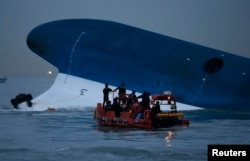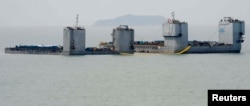An extensive South Korean salvage operation Thursday successfully raised the Sewol ferry, which capsized nearly three years ago, killing more than 300 passengers, many of them high school students.
“At 4:47am we lifted (the Sewol) 22 meters and entire body of the ferry started to show for the first time above the surface,” said Lee Cheol-jo, an official in charge of salvage operation with the Ministry of Oceans and Fisheries.
National tragedy
The sinking of the Sewol, with 476 passengers on board, during a routine journey from Incheon to the holiday resort of Jeju Island, April 16, 2014, triggered national outrage over the deadly accident that was later determined to be caused in part by greed, incompetence and negligence.
The ferry on that day was dangerously overloaded, hauling 3,608 tons of cargo despite a maximum cargo limit of 987 tons. It’s excessive weight made the vessel less stable, and it capsized while attempting to execute a turn at a high speed.
Many of the 250 teenagers, who died while on a school trip, were instructed by crewmembers to remain in their cabin, even as the crew abandoned ship. The ship’s captain Lee Joon-seok, who also abandoned ship, was later convicted of gross negligence and sentenced to life in prison, while 14 other crew members were sentenced to up to 12 years in prison for abandonment and violating maritime law.
The South Korean coast guard’s slow and indecisive rescue efforts also came under criticism. Officers later claimed they lacked the proper training and equipment to mount such a large-scale rescue effort at sea.
And public confidence in the government of then-President Park Geun-hye plummeted, and never recovered, over her perceived ineffective management of the crisis, and her own mysterious disappearance when she made no public statement or appearance for seven hours while the ferry was sinking.
The South Korean National Assembly cited Park’s negligence in handling the Sewol disaster, along with her alleged connection to a multimillion-dollar bribery scandal, when it voted to impeach the president in December. The Constitutional Court recently upheld the impeachment motion and a new presidential election is scheduled for May 9.
Recovery efforts
Families of the Sewol victims have been calling for the ship to be raised and for a more thorough investigation into the disaster.
The Sewol sunk in the Yellow Sea near the southeastern Island of Jindo. The salvage efforts to recover the 6,800 ton ferry had been delayed in part because of rough conditions at sea and complicated by requirements set to bring up the vessel intact, so as to aid the investigation into the cause of the accident, and to preserve any bodies that may still be on board. Nine victims are still unaccounted for.
A Chinese salvage company fitted 33 beams beneath the hull and used 66 hydraulic jacks to raise the hull of the ship, which was lying on its left side at a depth of 40 meters below the sea.
The recovered vessel will soon be moved to the nearby port of Mokpo on the mainland.
“We are calculating that it will take about 12 to 13 days to move the ferry to dry dock of Mokpo port,” said Lee with the Ministry of Oceans and Fisheries.
Families of the victims
, the head of a group representing the families of the Sewol victims, released a statement Thursday urging the government to “work on recovery of the missing victims first.”
The group also wants more government transparency and participation by opposition parties and victim’s families in the investigation process.
Lee Kum-hee, whose daughter is one of the nine victims unaccounted for, was on hand to witness the recovery. Moved to tears by the sight of the ferry being raised, she said, “it’s heart breaking, how cold she’s been there.”
Youmi Kim contributed to this report.
















